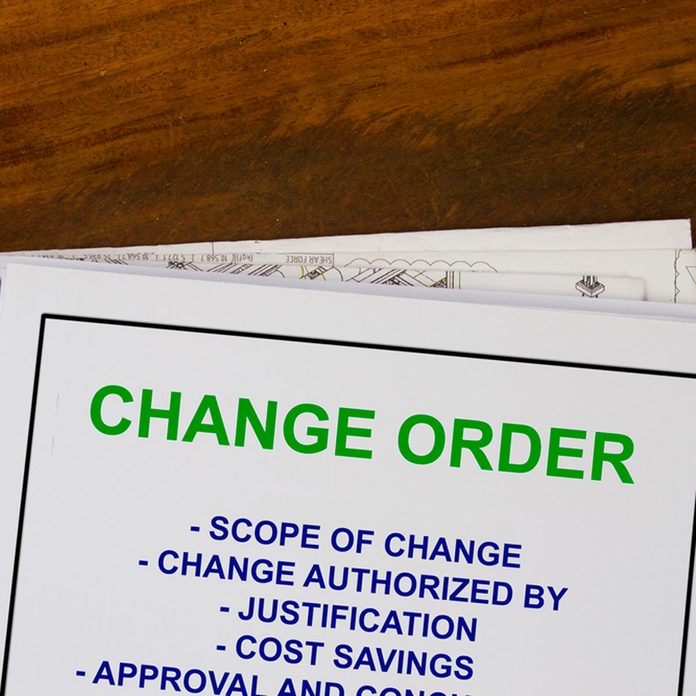
Communicate in Writing
The majority of issues between contractors and homeowners boil down to miscommunication and a lack of updates. All too often contractors get wrapped up in the project details and fail to give proper notification of daily progress and setbacks to the homeowners. While it’s best to establish communication from the get-go, if you are in a deteriorating relationship with your contractor, get the communication going again, and be sure to get everything in writing. Texts and emails are great for this; even when you have a verbal communication, let the contractor know that you’re going to send an email recapping the conversation to make sure you’re on the same page. This forces both of you to lay out your potential issues, and can be referred back to if more problems arise.

Be Understanding… to a Point
When working on a complicated project, it’s just a matter of time before something goes wrong. And it may be a mistake, or event that is beyond anyone’s control. (If you’re waiting to have the outside of your home painted, and it rains for two weeks, then a delay is inevitable!) An experienced contractor will not be thrown by short-term setbacks, and the project’s timeline should have enough leeway built in to accommodate typical issues. When your contractor gives you an update, keep in mind that they don’t want to tell you something didn’t go well, and a little understanding on your part can go a long way.
But, if it seems like your project is set back by issue after issue, or the problems are pushing the project beyond the original schedule, let the contractor know that you expect professionalism and a course of action to get the project back on track.

Establish Clear Milestones
As soon as you begin to have problems with the contractor, one of the best things you can do is to reestablish what the plan is going forward, and what time frame it will happen in the time frame in which it will occur. Are the workers who built your addition also trashing the yard? Put in writing exactly what will be done to rectify it and when it will be done by. (Again, a thunderstorm might postpone this, but a good contractor will be able to work around and have a little bit of a buffer to account for such things.)

Refer to the Contract
As you establish what you expect to have done, refer back to the contract any time the scope of the work or the timeline is in doubt. If you started work without a contract, it’s important that you establish something in writing as soon as possible! Once you’re having problems with the contractor, the longer you go with no formal agreement the more room there is for debate about things like payment amounts and due dates.
If you’re like many people, you may find contracts and negotiating tedious, at best.

Don’t be Afraid to Amend the Contract
This is an important one. If the job has gotten so delayed that the original timeline is impossible to meet, there’s no point in trying to hold your contractor to that milestone. Too many workers will be inclined to rush to make a deadline or simply give up, neither of which is in your best interests. However, if you move the goalposts to give your contractor room to breathe, then amend the original contract to make sure that you still have maximum options in case things go poorly.
The structure of the pay points will affect how your contractor thinks about your job, just as you likely think about how much money you want to have set aside at the various milestones of life.

Go up the Food Chain
If your project has problems that seem tied to the workers on the job site, you’ll probably want to bring their supervisors into the loop. Some building and remodeling companies have key personnel who bid on jobs and work with homeowners, but the actual workers may be less stellar communicators. In that case, demand that the person you have the relationship with come to the job site and help set things right (organizationally, if not physically). Many times, borderline employees or subcontractors will clean up their act when the person who signs their check is in the building.

Talk to the Subcontractors
Of course, sometimes the problem starts at the top. If you have concerns about the information you’re getting from the contractor, you may want to talk to the men and women doing the work, especially subcontractors. Ask the people doing hands-on work how things are going, and if you hear that they’re not getting paid or that they’re extremely unhappy, that’s a warning sign that your contractor is struggling with cash flow. But before you do this, be aware that talking to subcontractors and asking uncomfortable questions will almost certainly get back to the general contractor.
Making the contractor feel as though you’re going behind their back might aggravate an already tense situation. Be sure you’re comfortable with the fallout of this tactic, or are at a point where the relationship is almost beyond repair.

Change Orders and Scope Creep
This is another area where you want to be understanding, up to a point. Change orders occur when the scope of the job changes for one reason or another. If you decide halfway through a bathroom remodel that you want to upgrade from laminate counter tops to granite, naturally that will impact the timeline and price. Or if the demo for that bathroom remodel began and uncovered signs of a massive termite infestation, that’s an issue that likely wasn’t covered in the initial contract. But if the contractor is giving you a hard sell on alternate choices or upgrades, that’s a warning sign.
And, you shouldn’t be seeing additional change orders for basic work that should be included in the contract. Some contractors low-ball an offer to get a job, planning to up-sell later for basic services. This is one more area where the signed contract comes to the rescue. All of these expectations should be laid out in writing. And if a low bid seems too good to be true, ask about the details! Family Handyman has many tools to help ensure that any estimates are as accurate as possible, such as this guide to estimating a concrete order.

The Magic of the Payment Holdback
If you’re in the middle of a project and considering tweaking the terms of the contract or adjusting milestones, one of the best things you can do to protect your interests is to stipulate that there will be a holdback of final funds until all items are completed to your satisfaction. The more concerns you have about your contractor, the more you should hold back until you are fully satisfied. It’s amazing how fast things can get done when there’s money on the line!
And, while holdbacks are often used by homeowners to give leverage over a contractor, they can also be a way to give the contractors a hand. For example, if the supplier made a mistake and shipped two light fixtures instead of three, and the contractor has to wait a week to install the third, you may choose to pay them the majority of the final payment but hold back a few hundred dollars until the final light is in and installed. This protects you while also helping out the contractor and their subcontractors.
On large projects, you may also find that it makes sense to tie payments to a home improvement loan. This allows you to have the bank act as the “bad cop,” because draws won’t be released until construction milestones are fully met.

Escalation
Lastly, you can consider escalating the situation. Threatening to give bad reviews on sites such as Yelp, Angie’s List and the Better Business Bureau can quickly bring things to a head, for better or for worse.
Ideally, you’ll get along with your contractor and they will be motivated to do excellent work both out of pride in their craft and goodwill toward you. But, if the only way you can ensure that your job is done correctly is to hold a threat of poor reviews or slow payment over their head, you should be willing to do so. If things are going very badly, don’t hesitate to contact a legal professional. By the time you get to that point, it’s a good idea to keep a very close eye on the contractor’s work in order to make sure they’re not cutting corners. If you don’t have the training to do that yourself, ask around and see if you have a friend who can help out. Check out the 10 home improvement projects for which you should always hire a pro.